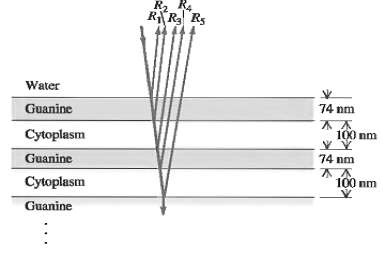Reflective Coatings and Herring. Herring and related fish have a brilliant silvery appearance that camouflages them while
Question:
Reflective Coatings and Herring. Herring and related fish have a brilliant silvery appearance that camouflages them while they are swimming in a sunlit ocean. The silveriness is due to platelets attached to the surfaces of these fish. Each platelet is made up of several alternating layers of crystalline guanine (n = 1.80) and of cytoplasm (n = 1.333, the same as water), with a guanine layer on the outside in contact with the surrounding water (Fig. 35.24). In one typical platelet, the guanine layers are 74nm thick and the cytoplasm layers are 100 run thick.(a) For light striking the platelet surface at normal incidence, for which vacuum wavelengths of visible light will all of the reflections R1, R2, R3, R4, and R5, shown in Fig. 35.24, be approximately in phase? If white light is shone on this platelet, what color will be most strongly reflected (see Fig. 32.4)? The surface of a herring has very many platelets side by side with layers of different thickness, so that all visible wavelengths are reflected.(b) Explain why such a "stack" of layers is more reflective than a single layer of guanine with cytoplasm underneath. (A stack of five guanine layers separated by cytoplasm layers reflects more than 80% of incident light at the wavelength for which it is "tuned.")(c) The color that is most strongly reflected from a platelet depends on the angle at which it is viewed. Explain why this should be so. (You can see these changes in color by examining a herring from different angles. Most of the platelets on these fish are oriented in the same way, so that they are vertical when the fish isswimming.)
Step by Step Answer:

Introductory Statistics Exploring The World Through Data
ISBN: 9780321978271
2nd Edition
Authors: Robert Gould, Colleen Ryan





